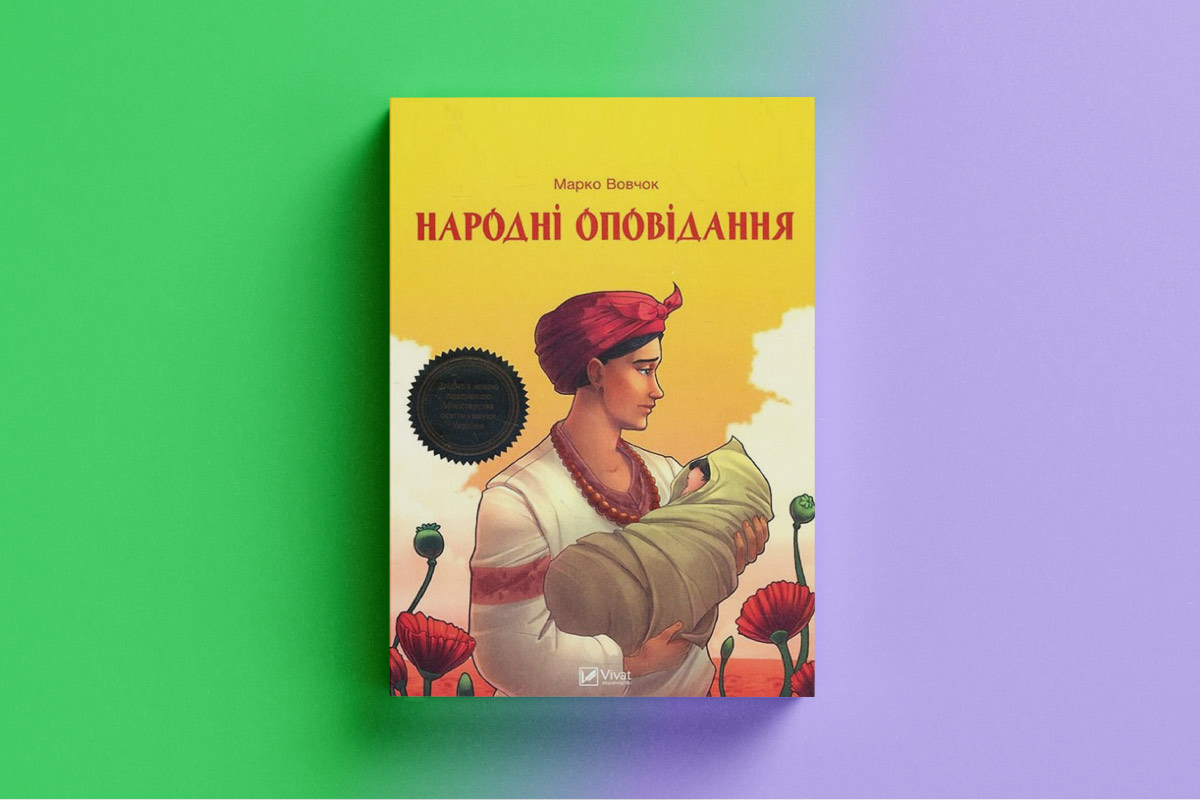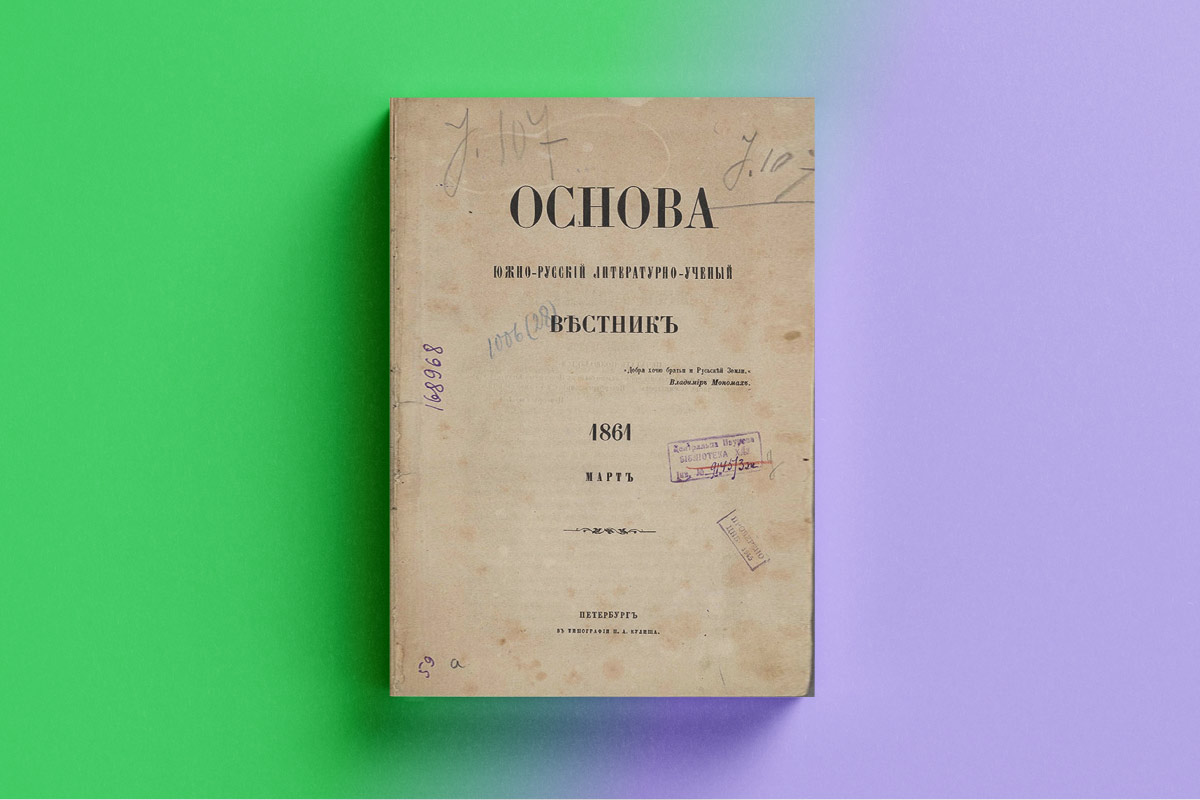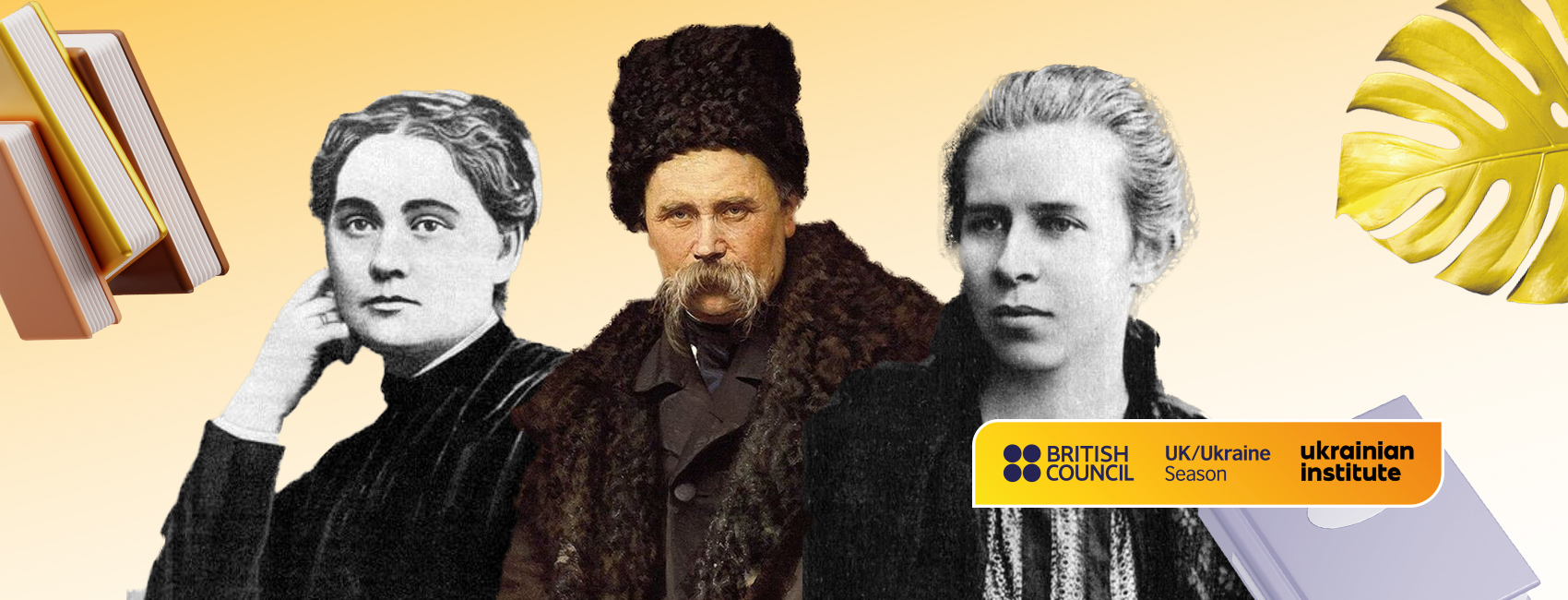* ESC - закрити вікно пошуку
PORTRAITS OF OUTSTANDING people
Maria, Marko and Maria Again: How Marko Vovchok Loved and Wrote
26.01.2023
Year 1872. An outstanding figure of the literary world of that time, a popular writer in her homeland, an editor-in-chief of the magazine “Translations of the Best Foreign Writers”, a close friend of writers Jules Verne, Ivan Turgenev and a publisher Pierre-Jules Hetzel and a celebrity of the literary salons of Europe decides it is the time for a radical change.
Maria Vilinska, better known by her pen name Marko Vovchok, simultaneously breaks with all her life in St. Petersburg and moves to the province, to a small estate of her friends in the Tver province, to make a fresh start. However, the reason for this is not only a conscious choice, but also insurmountable circumstances, old mistakes and vindictiveness of her old enemies… This could be a good start for a Hollywood movie, but is a real episode from the biography of a Ukrainian writer, translator and one of the key figures of Ukrainian literary scene of the second half of the 19th century.
The life of Maria Vilinska was full of such stories — bright and with great serial potential. In addition to a rich life and love story, however, this woman left an equally outstanding corpus of texts that became the foundation of Ukrainian women’s literary tradition and for the first time in Ukrainian literature raised the themes of emancipation and freedom of women.
So who was she, this Marko Vovchok and this Maria Vilinska-Markovych?

Education of Emotions
Maria Vilinska was born on 22 December, 1833 in the estate of Yekaterynynske, Orel province (present-day Russia). Her father, a retired colonel, died quite early, and her mother, looking for a way out of financial pressure, married for the second time — unsuccessfully, though (her second husband turned out to be a drunkard and a rake). In 1845 her mother sent Maria to a private boarding school for noble maidens in Kharkiv, but in 1847, the girl moved to Russian Orel, where she settled in the family of her aunt Kateryna Mardovina.
The latter often arranged literary salons in her estate, to which she also invited Maria, worrying about her destiny (just wanting to marry her, in fact) — although in everyday life she used her as a governess for her children for free. At one of these literary evenings, 17-year-old Maria met one of the leading representatives of the “high society” in Orel, landowner Yergolsky, and the folklorist Opanas Markovych, who was 11 years older. Both men were interested in a quiet, unsociable gray-eyed girl…
“Isn’t that too many details?” — you may ask. No way to make it different. The second important fact about Maria Vilinska’s creative and personal biography is that many of her works are autobiographical. In particular, one of her first novels — “The Living Soul” — was published in 1868 under the pen name Marko Vovchok. The plot of this work was based on the dramatic events experienced by Maria herself in Orel: despite her aunt’s exhortations, the girl rejects the courtship of Yergolsky and, despite her aunt’s threats to simply throw her away, decides to marry Opanas Markovych.
Thus, Masha from “The Living Soul” is an ardent idealist, imbued with “women’s question”, who wants to earn her own living and be a person, not a decoration, next to her husband — and one of the first emancipatory characters in Ukrainian literature, a forerunner of the “new womanhood” and an actual “cast” from the biography of the author.
However, if for the fictional Masha this step ended up with a happy ending, for the real one it was only the beginning of a long journey. In particular, very soon the world-famous pen name “Marko Vovchok” will appear on it.

Marko Vovchok “The Living Soul”
“Vovchok” (wolfie) or a writer?
After their marriage the couple settled in Nemyriv (present-day Vinnytsia region, Ukraine). At the suggestion of her husband, Maria became interested in the Ukrainian literary scene and context and began intensive study of the Ukrainian language. Despite her remarkable success in this direction, however, as a person who spoke and wrote in Russian most of her life, she needed an editor. Panteleimon Kulish, who had a printing house in St. Petersburg did not pay much attention to the manuscript at first. However, after reading it, he was delighted, and this delight was further enhanced by his personal acquaintance with the author, which eventually grew into a romance affair. Hence, Kulish gladly began editing the debutante’s text and preparing it for publication.
After its publication in 1857, “Narodni opovidannya” (“Folk Tales”) had a tremendous success in Ukrainian reading circles. This gave rise to numerous speculations and doubts around the book. First — a Russian could not have written texts in such perfect, rich Ukrainian language! Second — obviously, the laurels for the “Folk Stories” belong not to the “impostor”-Russian woman, but to her husband Opanas Markovych, or the editor and publisher Panteleimon Kulish. The latter himself was quite eager to hear these rumors, because their tempestuous romance with Markovycheva eventually was reduced to nothing.

Marko Vovchok “Folk Stories”
And the very pen name, under which the works were published, — Marko Vovchok — raised many questions. As of the mid 19th century, no one would have been surprised that the writer published her works under a male pseudonym — “Georgesandism” (named after one of the leading representatives of the phenomenon, the French writer Georges Sand) was a popular phenomenon in world literature of that time. However, not everything was so simple with Ukrainian “pearl”-debutant. Some of the readers believed that the pen name (in fact, the altered marriage name of the writer, “Markovycheva”) indicated the authorship of Markovych.
The offended Panteleimon Kulish insisted that the pen name, works, and the subsequent fame of Maria Vilinska-Markovych were almost exclusively his merit. Anyway the writer herself did not like this pen name: she never signed her letters with it, using only her real name, Maria Markovych.
And what is under the cover of the “Folk Stories”? The first volume of the collection (there was another one, published in 1862) includes 11 stories: “Sestra”, “Kozachka”, “Chumak”, “Odarka”, “Son”, “Panska Volya” (later titled “Horpyna”), “Vykup”, “Svekruha”, “Znay, Lyashe!” (later titled “Father Andriy”), “Maksym Hrymach” and “Danylo Hurch” (later titled “Cossack Blood”). Along with colorful everyday sketches and rich, lush language of both the characters and the works, Marko Vovchok creates a number of full-blooded images of Ukrainian peasants.
And the leading place is taken by women. They are the main, if not explicit, emotional drivers of the plot, they feel deeply, strongly and fatally, and that is exactly what gives the stories the atmosphere of ballads, almost magical realism. It is through female images that Marko Vovchok’s texts convey both the connection of man with nature and the touch of the afterlife (which is actually a way of self-knowledge in this prose).
Marko Vovchok’s contemporaries and successors highly appreciated her works, but none of them managed to achieve such a subtle combination of romantic and realistic aesthetics — not to mention women’s images, voices, sensuality.
At this stage Marko Vovchok, Maria Markovych, clearly felt what it was like to make a writing career in an all-male environment. Whatever the real origin of her pen name was, it was created by the same environment and weighed on her, imposing the rules of the game in a world that Mariya Markovych did not feel acceptable for herself. But if anyone, she learned well: instead of obeying other people’s rules, it is better to create your own.
European horizons
In 1859, Maria Markovych and her husband left for St. Petersburg, finally breaking up with Panteleimon Kulish. The writer immediately finds herself at the epicenter of Ukrainian cultural life at a new place: many Ukrainian projects are realized here. Maria gets acquainted with representatives of both Ukrainian and Russian literary beau monde of the time.
In particular, Taras Shevchenko personally “sanctifies” the talent of Maria Markovych with his high appreciation and affection. However, the Markovych family did not stay in St. Petersburg for too long: during 1859-1867 they and their son Bohdan lived in different European countries. To be more precise, in 1862 Markovych returned to Ukraine alone.

“Basis. Southern Russian Literary and Scientific Bulletin”, March 1861, Petersburg
In 1859, the Markovych couple traveled to Europe. France, Italy, Switzerland, Germany — from these trips Maria Markovych brings not only nice impressions, but also valuable acquaintances. Among these are Russians Alexander Herzen and Leo Tolstoy, and classics of European literature Jules Verne, Prosper Mérimée and publisher Pierre-Jules Hetzel. In particular, Jules Verne (who is believed to also have admired Maria) later granted her an exclusive right to translate his own works into Russian.
Prosper Mérimée, having read “Folk Tales”, translated by Ivan Turgenev, in his letter to the writer Jeanne Daken, said that this author surpassed even “Uncle Tom’s Cabin” by Harriet Beecher Stowe.
And with the assistance of Pierre-Jules Hetzel, a translation of Marko Vovchok’s story “Marusya” about a brave girl who helps Zaporizhzhya Cossacks is published in Paris. The book quickly gained great popularity, and is translated into several other languages and even is studied at the French schools.
During this period, Maria Markovych is developing the socio-psychological theme in her works. She completed the story “Three Destinies”, the stories “Not a Match”, “Tyuleva Baba”, “Lazybone”, “Two Sons” and others, which were included in the second volume of “Folk Stories”. However, the Valuev Circular of 1863, which imposed a ban on the publication of fiction for the general reading public in Ukrainian, prompted Maria to write and publish all subsequent works in the Russian language.

Marko Vovchok “Three Destinies”
So in the future, Maria Markovych focuses on translation activities. She had an agreement with Pierre-Jules Hetzel and Russian publisher Semyon Zvonaryov to publish translations of French prose into Russian. In particular, over the following years, she translated 15 novels by Jules Verne, Charles Darwin’s “Origin of Species” and a number of other books.
This activity, among other things, allowed her to earn a living in Europe with her young son, albeit not for long: in 1867, Maria Markovych moved to St. Petersburg again, where she founded “Translations of the best foreign writers” magazine. In 1872, the magazine, and Maria herself, found themselves at the epicenter of a scandal related to plagiarism — after which she became unwelcome in literary circles, and the magazine’s activities were curtailed. Thus, Maria Markovych finally decides to leave Marko Vovchok in the past and start a new life in Stavropol, and she succeeds in her personal life, but, unfortunately, not in her writing.
The biography of Maria Markovych is full of dramatic turns and changes, and one can treat it differently. However, the writer remained true to herself in her work. Both by her own example and the example of her female characters — both intelligent Masha from “The Living Soul”, and peasant women Katrya from “Three Destinies” or Natalka from the story “Danylo Hurch” — Marko Vovchok — Maria Vilinska-Markovych demonstrated a new character, a new woman. She knows what it is that she wants, strives to live by her own mind and her own will, and unfreedom for her is worse than death.

Yes, these are still very early, often overly radical and idealistic expressions of feminist views in literature, but they already echoed the European feminist movements of the time (which is not surprising, given how long the writer lived in Europe). More importantly, Marko Vovchok gives these traits (freedom, integrity, depth of experience and sensitivity) to her characters — representatives of the common people, while repeatedly reflecting on the injustice of traditional roles assigned to women by the society.
The story “Tyuleva Baba” directly ironizes the “peculiarly female” struggle for the role of the best housewife. Horpyna from the story of the same name goes crazy from the grief of losing her child, because she literally has no chance for any other life, and all three characters of the story “Three Destinies” have to live completely different lives from what they wanted, only because all three fell in love with the wrong person.
The transformation of one’s own life into an artistic act is a thesis of much later modernism. However, Maria Vilinska-Markovych was ahead of her time in many ways, which allowed a whole cohort of female writers to reveal themselves in the following decades.
And in the history of Ukrainian literature, she, first of all, remains not a femme fatale, but the first woman who managed to become a classicist at the age of 25, and start a women’s literary tradition that continues to this day, echoing in the voices of our contemporaries.
A list of work for translation:
- Collection of works “Folk Tales” (vol. 1, 2)
- Novel “The Living Soul”
- Novella “Three Destinies”
- Novella “Marusya”
- Novella “Instytutka”
- Short-story “Vykup”
Copyright for all texts is free now.
The material was created and published as part of the project “MC2C (Media City to City): Creating city-to-city media connections for local and Ukrainian diaspora audience needs”. It is implemented by Lviv Media Forum in partnership with Thomson Media and with the support of the Federal Foreign Office of Germany.
The information or views expressed in this material are the responsibility of the authors.
This publication is sponsored by the Chytomo’s Patreon community
що більше читаєш – то ширші можливості




